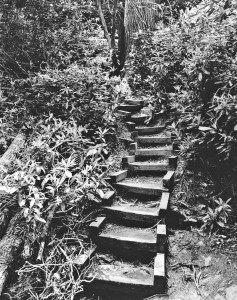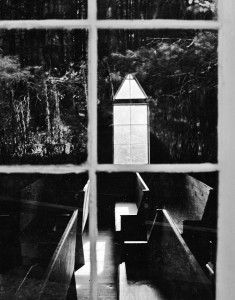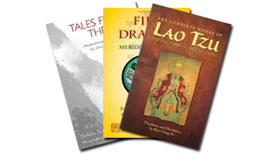Feng Shui Guidelines to Energy Flow Analysis: What is Qi and How Qi Flows
by Elliot Jay Tanzer
Photos by Susan Glover Logan
There are many approaches to Feng Shui that have developed over the millennia, as in all indigenous cultures, all beginning with good, old-fashioned common sense – don’t put your shack on a windy hilltop, it will get blown away; don’t put your house in a flood plain, it will get washed away. The concept of how to live harmoniously in whichever environment you choose to live, doesn’t get more basic than that. Anthropologists exploring the most distant places have written endlessly about what a particular culture would consider important, whether arranging teepees in a circle among teepee building Native American tribes, how to stay warm in an igloo in the freezing north, or building on stilts in the very wet Amazon.
However, among all the world’s people, no other culture has applied such focused attention in examining the most beneficial way of siting and building a human dwelling to the degree of refinement as the Chinese. In Chinese society this same attention to detail and subtlety can be seen in all areas of life even hundreds of years before China was unified in 221BCE. Out of this study and constant refinement comes Traditional Chinese Medicine (TCM), various martial art styles, and of course Feng Shui. All of these cultural achievements sharing a common diagnostic language of how qi flows, and how it can be differentiated in Yin-Qi and Yang-Qi, further dividing into the Yin and Yang Qi of the Five Elements, or Phases, which ultimately gives birth to the “ten-thousand things” as mentioned in the venerable Dao De Jing, referring as it does, to all of manifest existence.
As in various styles of TCM and the various martial arts styles, so too, Feng Shui has developed different styles. As mentioned, the earliest was the application of common sense passed on from generation to generation, from elders of the community to the young and inexperienced, from those familiar with how to live skillfully in a particular ecology to the newcomer who just moved into the neighborhood. This common sense approach developed into what is now called Landform Feng Shui.
Landform Feng Shui, as the name implies, and like all things Oriental, draws its wisdom from nature, starting with a description of the ideal home site – a mountain behind for support, a view of the valley below for security, a slight rise on either side for protection. In modern parlance we label this comfortable and secure arrangement the Armchair Configuration. In ancient days, it was described as the Four Celestial Animals: Tortoise behind, White Tiger and Azure Dragon on either side, and the small Red Phoenix, like a foot stool in the foreground, enabling us to see the view and to see who or what is coming our way.
It can be said that Landform Feng Shui is the foundation upon which all other styles of feng shui stand upon for their efficiency and effectiveness. Without good “forms” the later development of traditional techniques of the Compass School or the even more modern innovation of the 3-Door Bagua of the Black Sect Tantric Buddhist School, though bringing some short term results, would in the long term be little better than spitting in the wind, or in the water. And all Landform analysis is based on how the qi flows.
What Is Qi?
Qi is the Chinese word for “energy.” Everything animate and inanimate, real or conceptual, has qi. Different people have different qi. Each kind of animal has its own kind of qi. A nation has its qi and a religion has its qi. There is roadway qi, rock qi, locational qi, and vocational qi. There is soft-yin qi and hard-yang qi. There is children qi, male and female qi. Each item of food has its unique qi. To identify the qi of anything animate or inanimate, real or conceptual, is to understand its essential nature. Qi is the Isness of whatever is – the essence of the thing or situation. If your goal is good health and success in all areas of your life, there is no other concept more important than the study and understanding of qi, and how qi flows.
Why Feng Shui
The study of how qi in our working and living environments affects us is called feng shui (füng sch’way). The art and science of feng shui is based on many thousands of years of observation and application. Knowing the feng shui of how our environment affects us allows us to alter the qi flow to be more beneficial. Feng shui techniques allow us to mitigate the negative influences while enhancing the positive ones.
The Chinese words feng and shui are actually descriptions of qi flow. “Feng” means wind and “shui” means water. Feng, as wind, refers to the invisible or intangible qi that flows through a space. Shui, as water, is the visible, more tangible flow of qi. The study of feng shui encompasses all the ways that qi can have an effect on the inhabitants of any specific environment.
How Do You Know If You
Have Good Feng Shui?
The answer is: Are you happy and healthy? Are you enjoying prosperity, or at least more than enough to provide for your needs? Do you have a good reputation? Do you have a committed, mutually supportive and satisfying personal relationship? Are your children thriving, respectful, and socially conscious? Are they creative and successful academically? If your answer is “yes” to each of these questions, then the answer to the original question is: “Yes, the house you are living in has good feng shui.”
If your house does not have good feng shui for wealth, you are always running to catch up. If your house does not have good feng shui for health, you are often tired and stressed. If your house does not have good feng shui for relationship harmony, you are single (which in some cases might be a life style choice), or you are in an unhappy relationship, and might as well be living alone. If you have children and they are a source of ongoing concern, grief, and melodrama, it could be yet another indicator that your home has unfavorable feng shui.
Of course, the feng shui of your house may be just good enough, so that you are doing well in some of these areas, while not doing well in others; or, not doing well in one area may be distracting you from doing even better in all the others.
The Nature of Life-Giving, or Upward Moving Energy – Sheng Qi
All beneficial qi is pleasant, uplifting, and inspiring. It is anything that is pleasant to smell, hear, or look at. Beneficial qi flow is smooth, graceful, and its movement can be described as meandering. Meandering qi is nourishing and easy to accumulate. Anything that allows us to relax and encourages us to interact with others harmoniously reflects good qi and good qi flow. Good qi enables us to maintain concentration, productivity, and enthusiasm, as well as restful sleep, intimate relationships, and moments of quiet contemplation. Good qi flow attracts opportunity, and the awareness to take advantage of a good opportunity when it comes our way. An environment that has meandering qi flow is harmonious to live in. Everything in nature – including people – that is vibrant and joyous is an example of life-giving qi. Calm, meandering, pleasant qi is the standard against which all other qi can be measured. The Chinese words for life-giving qi is sheng qi – literally, “upward moving energy.”
Sha Qi – Noxious Energy
That Takes Life Away
When qi moves too fast, too slow, is excessive or deficient, is overbearing or distracting, or is in any way extreme, it is an example of sha qi. Sha qi is noxious, stress producing, and unhealthy. Sha qi undermines our vitality, focus, enthusiasm, and emotional equanimity. Sha qi is also referred to as “killing qi.” It can be said with certainty that sha qi literally takes life away.
In evaluating a home we are currently living in, or in our search for a property and home design that supports a fulfilling life, we must be conscious of the environmental sources of unhealthy sha qi. The important goal of a feng shui diagnosis, is not only to encourage good qi to accumulate, but also to identify the presence of sha qi and then consider ways to transform it to the more desirable and beneficial life-giving sheng qi.
Hidden Arrows – A Type of Sha Qi
In contrast to life-giving, smooth flowing, meandering qi, anything in nature that moves in a straight line is a form of sha qi. Sha qi that comes from straight lines, sharp and pointy edges or angles is called a “hidden arrow.” Some call hidden arrows “poison arrows.” Hidden arrows or poison arrows “shoot” qi rapidly in the direction the “arrow” is pointing.
The sha qi from “hidden arrows” are destructive. This can be seen when we compare a gently flowing stream to a rushing river. Such a fast moving river strips the trees from its banks. Or when we compare an animal peacefully foraging in a forest compared to a panicked animal crashing through the same forest, breaking branches and trampling foliage underfoot. A straight line enables qi to flow too fast. The natural human response to a “hidden arrow,” whether a flash flooding river or an animal raging out of control, is to get out of the way as quickly as possible. The need for security and feeling safe motivates many of the suggested feng shui solutions.
The presence of “hidden arrows” in the home elicits the same response of getting out of danger’s way. For example: if you were seated in your dining room eating dinner and someone was standing in the corner pointing a bow and arrow at you, understandably you would be tense and nervous. You would ask them to put it down, or at least point it in a different direction. Even if instead of a live person, it was a statue of the beautiful huntress Diana with her bow and arrow carved out of wood or stone, you would still feel uneasy. Without too much hesitation you would soon get up, turn the statue, and point the arrow in a different direction – a direction away from you.
Some “hidden arrows” are quite obvious, while others are very abstract. They are embedded in the environment and are not clearly perceived as an actual arrow shaft with a life-threatening, sharp-pointed arrowhead. Consequently, many “hidden arrows” are often ignored by the conscious or rational mind.
Though ignored by the conscious (rational) mind, the subconscious (emotional) mind continues to squirm in its little understood attempt to get out of the way of danger – to get out of the “line of fire.” People often sense something is wrong, but have difficulty identifying the problem. Presented with an angle of the wall, a sharp corner of furniture, or a pointy-leaf plant, the subconscious prepares for the inevitable impact of this “arrow,” even though in reality, it will never fly forth. To the subconscious (emotional) mind there is no differentiation between the illusion of danger, and the dangerous situation that is real. The subconscious will do whatever is necessary to avoid danger without the more consciously aware rational mind necessarily being aware of what evasive action may have been set into motion.
How “Hidden Arrows”
Undermine Health
This constant tensing in anticipation of being hit and hurt keeps the adrenal glands’ ‘fight and flight’ response at high alert. Along with the adrenal glands secretion of the ‘fight and flight’ hormone adrenaline, other symptoms of a body in tension are: accelerated heart beat, high blood pressure, and rapid and shallow breathing. If this tense posturing continues unabated for prolonged periods of time, day after day, year after year, the immune system is ultimately undermined and various health problems are likely to manifest. Practitioners of Traditional Chinese Medicine call this Triple Warmer Meridian activation.
At the same time the immune system is weakening, the area of the body in direct line of the “hidden arrow” becomes inflamed. It eventually collapses when put under real pressure during sports or even normal everyday activities. The blame is quickly put on the activity instead of on the real culprit, the environmental presence of a “hidden arrow.” Like all sha qi, “hidden arrows” need to be removed, blocked, or deflected.
Qi Flows In Many Ways –
Landform Feng Shui
The first challenge of a feng shui diagnosis is to determine how qi flows to, through, and around the home, and then to identify if it is beneficial or detrimental. Beneficial qi flow can be enhanced and energized, or enjoyed just as it is. But it is of the utmost importance to identify the problem areas that are causing unfortunate sha qi. Once you identify the problem areas, your next challenge is to find solutions, solutions that will regulate the qi flow to ensure that it flows smoothly and abundantly.
In nature, rivers, mountains, valleys, trees, meadows, pathways, and other landscape features are all channels for qi flow. In cities, this translates as roadways, alleyways, buildings, and open spaces. Inside a home, qi flows through an “internal landscape” of doors, windows, stairways, and hallways, and is assisted or blocked by furniture, appliances, design elements, and structural components of the house. As we have seen, when qi flow to, through, or around a home is obstructed, stagnant, or excessive, the health and well-being of the inhabitants are adversely affected. In contrast, smooth and abundant qi flow through the “outside and internal landscape” results in a sense of self-assurance and a more positive outlook – a sense of being in the flow.
Whether mountains or rivers outside or furniture and hallways inside, this approach is called Landform Feng Shui, and is the foundation upon which all other systems of feng shui depend for their efficiency and long-term effectiveness. As with all systems of feng shui, the goal of Landform Feng Shui is to attract, accumulate, and hold on to the good qi long enough for it to be enjoyed as a benefit, before it flows on again.
Feng Shui to the Rescue –
Working Smarter, Instead of Harder
Another useful metaphor for the home is its comparison to a bucket-like container – a container that holds energy. Imagine going to a well, filling your bucket to the brim, only to discover upon arriving home, the bucket was riddled with holes of various sizes, and is empty; if you are not aware the bucket has holes, you might run around frenetically trying to replace what was lost until you collapse from exhaustion.
Instead of racing madly around trying to keep a leaky container full, you can use the Feng Shui Checklist to identify the “energy leaks”, and then cleverly “patch the holes.” In this way subsequent trips to the well will be more successful. In short, by removing, blocking, or deflecting sha qi we make the container-like home stronger. Problem solving solutions are called remedies, cures, or countermeasures. Solutions to make a good situation even better are called enhancements or energizers.
Of course, if the identified sources of sha qi cannot be removed, blocked or deflected, as some sources of sha qi are more detrimental than others, a decision has to be made as to how serious the problem is? Once the problem has been identified, almost all situations can be easily remedied. In the worst case scenarios, the only solution is to pack up and move. The Feng Shui Checklist format is available at www.elliottanzer.com and was designed to enable you to evaluate all the possible ways sha qi can be found in and around the home.
Creating Harmonious Qi Flow
Everything felt by our senses is evaluated by both the conscious (rational) mind as well as the subconscious (feeling) mind. It is a natural inclination for living things to be attracted to that which is soft, curvy, and accommodating, and to feel rebuffed or put off by that which is hard, angular, aggressive, and uninviting. By improving the household qi, you improve your own personal qi with more calm, equanimity and joy. By applying feng shui principles and methods, you will be able to create beneficial qi flow in the home, and enjoy a happy and harmonious life.
Examples of Qi Flow:
The Basis for the Questions on
the Feng Shui Checklist
Life-Giving, or Upward Moving (Sheng) Qi – Qi Flow Which Can Be Enhanced
• Meandering qi – moves along casually and gracefully. It is qi that is the most nourishing and easiest to accumulate. It encourages focus and stability, and translates as a natural rhythm. Meandering qi leads to harmony, which expresses itself as good health, prosperity, and nurturing relationships. It is pleasant, calming, and enjoyable. Meandering qi signifies the ideal. The qi of all things can be evaluated and compared to this standard.
• Expansive qi – is open, light and gives a feeling of spaciousness and comfort.
• Positive symbolic qi – is found in images, items, or certain patterns that are psychologically uplifting, inspiring, and motivating.
Forms of Sha Qi – Qi That Needs to Be Adjusted
Sha qi is detrimental. Most feng shui solutions are designed to prevent sha qi and increase good, sheng qi. Sha qi can express itself in any of the following ways:
• Fast moving qi – needs to be slowed down. Fast moving qi from long hallways and heavily trafficked roadways can over-energize the adrenal glands and leads to physical fatigue.
• Excessive qi – needs to be diffused. Excessive qi from large windows and found in large spaces is over-stimulating and leads to loss of focus and nervous exhaustion.
• Obstructed qi – needs to be unblocked. Obstructed qi from clutter, blank walls, and poorly positioned furniture causes frustration and leads to stress, anxiety, and inertia.
• Stagnant qi – needs to be freshened. Stagnant qi from standing water or poor ventilation is unhealthy, devitalizing, and leads to depression and poor health.
• Compressed qi – needs to be redirected. Compressed qi from overhead beams or slanted ceilings inflames the area of the body “under pressure,” making it vulnerable to injury and illness.
• Chopping qi – needs to be deflected or diffused. Chopping qi from overhead fans generate fear and uncertainty. Ceiling fans directly above the head disturb the heart and nervous system.
• Split qi – needs to be unified. Split qi from pillars and structural supports is disorienting and leads to confusion, misunderstanding, arguments, and indecisiveness.
• Excessive yin qi – needs to be dried out and warmed up. Excessive yin qi from too much water, lush foliage, or dark shadows encourages mold growth and poor air quality and leads to problems of the urinary tract, kidneys, and lymphatic system.
• Excessive yang qi – needs to be moistened and cooled down. Excessive yang qi from too much heat or bright lights leads to frantic activity, overheating, and dehydration. This can stress the heart, raises the blood pressure, dries the kidneys, and exhausts the adrenal glands.
• Negative symbolic qi – is found in images, items, or certain patterns which have negative associations with death, divorce, sickness, fears, painful situations or memories, and so on. Negative symbols need to be removed, as they can result in depression, anxiety, relationship disharmony, and ill-health. Only use symbolic qi that is positive and uplifting.
Elliot Jay Tanzer has offered astrological services since 1974 and feng shui services since 1995, and has presented at many astrology and feng shui conferences, whole life expos and metaphysical societies. He is also the author of Evaluating Astro*Carto*Graphy Maps: Finding the Best Places for You to Live & Travel – A Step by Step Guide. His books, audio and video library, ASTROLOG: A Daily Planning Guide for ALL Sun Signs, his Article Archives and the over 150 problems listed on the Feng Shui Checklist can be found at his website: www.ElliotTanzer.com. For more information about consultations in person, by phone or via Skype anywhere in the world you may live, contact Elliot by email: et@ElliotTanzer.com, or by phone: 310-281-6798.




